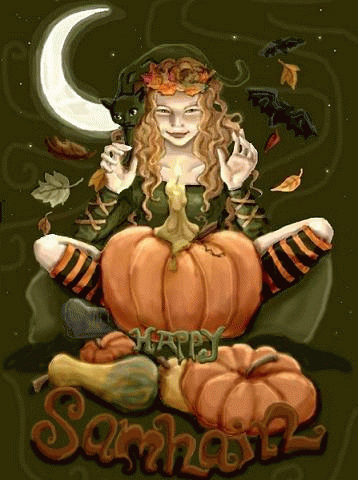Tis the season opener when the US begins its annual spending, feeding, partying, celebrating, decorating frenzy that includes a nod, usually, to the God of our understanding. One of my favorite holidays is Samhain (pronounced sow' en), which I usually practice as a Halloweener Â- dressing up in some costume that portrays a fantasy. Make-believe has always been fun to me. This year I decided to give more than a nod to my paganism by calling on our more serious practitioners for essays on the subject. Â
This compendium describes aspects of Samhain, its history, its traditions and how individual Pagans view the celebration. I claim no authority on the subject, but merely serve as an editor to the many articles submitted in response to my request. I am grateful for everyone's thoughtful submissions. My hope is to capture a snapshot of this multi-faceted religion for the interest of OEN readers.Â
Witch Deborah Oak Cooper, a member of the Reclaiming collective, told the San Francisco Chronicle, "There's no clearinghouse. It's the most disorganized religion, and that's part of the appeal." SFGate's Susan Fornoff explains, "So there are Neopagans and Wiccans and Rosicrucians, Faeries, Druids, Gardnerians, Asatru, worshipers of the God, worshipers of the Goddess, worshipers of nature."Â
Samhain marks the new year when Pagans honor their ancestors. Of the three-day celebration, the second day is neither part of the old year nor part of the new. Mythologically, it is the day when the veil between the living and the dead is thinned, and communication between the two worlds is possible. I've paraphrased others to give an overview.Â
Emmon Bodfish explains that "Samhain marked the absolute end of the harvest" culminating in an all-night party replete with food, song, games, ceremony and elections: Â
"Like New Year's Celebrations everywhere, Samhain festivities fall into two sequential phases; one that signifies a return to Chaos, e.g. disposal of old goods, expelling of evil, reversal of usual habits of behavior, parties, suspension of taboos, and the return of the dead, all on Samhain night; and a second which signifies re-birth of the Cosmos and creation anew, e.g. lighting of new fires, beginning of a new season, inauguration of new ceremonies, and installation of new leaders." Â
Isaac Bonewits and Robert Larson write: "Samhain is summer's end, the eve of All Saint's Day, All Hallow's Evening or Halloween. It is the beginning of the winter half of the year and is known as the Day Between Years. The day before Samhain is the last day of the old year and the day after Samhain is the first day of the new year (though for clarity's sake, most Druids assign each Samhain to the year following it). Being a day "between years," it is considered a very magical night, when the dead walk among the living and the veils between past, present, and future may be lifted in prophecy and divination."Â
Druids, according to one source comprise "An order of male and female priest-philosophers of pre-Christian Celtic society, known in Continental Europe, the Mediterranean basin, Great Britain, and Ireland; often thought to be comparable to Roman flāmines or the brahmins of India. According to classical commentators, druids in Gaul, and perhaps elsewhere, had authority over divine worship, officiated at sacrifices (including, perhaps, human sacrifices), exercised supreme authority over legislative and judicial matters, and educated à �lite youth along with aspirants to their order.Â
Bodfish continues:Â In the Druid afterlife, people and gods mingled in a sunny world, but outside of time. There is no one god of the dead comparable to Pluto or Hades. The Druid afterlife is more an Other World than an Under World, in which gods and people mingle in a timeless dimension. All the gods, and one's own merits and clan connections seem to determine one's place at the perpetual feast in the Isle of the Ever Young."Â Â Â
In this collection:Â
A Crone offers a detailed look into how she and co-religionists celebrate, honor, and mourn ancestors and Beloved Dead: M. Macha NightMare, Why I Love Samhain (3,075 words);Â
A Pacific Northwest Pagan contemplates the season of Samhain and its meaning in her life: Renee Randol, The Season of Samhain (143 words); Â
Suggestions on how to honor ancestors are given: Mike the Fool, How to Honor Ancestors (975 words);Â
A Druid considers sacrifice: Mortus, the Morose Druid, A Few (?) Thoughts About Samhain and Sacrifice (2,774 words);Â
Reflections on a hand fast anniversary, and the pursuit of happiness, are made: Justin Staley, Being a Pagan this Halloween (808 words);Â
An Arch Druid gives querulous voice to the season: Helgaleena Healingline, Samhain Up (622 words);Â
One practitioner explains the connection between bobbing for apples and Halloween: Stacey Weinberger, Apples of Samhain (1,128 words); and Â
A featured essayist in Druid Missal-Any Magazine details how the Reformed Druids of North America honor the dead during Samhain: Emmon Bodfish, The Other World (826 words).Â
Perhaps this batch of articles covers most questions any curious minded folk have about Pagans and Samhain. Much thanks to DarkLady for reaching into communities and soliciting Samhain articles, and for fielding the offerings. I hope to present a similar type of collection for the Winter Solstice. Let me know what you think.Â
Blessed be.





